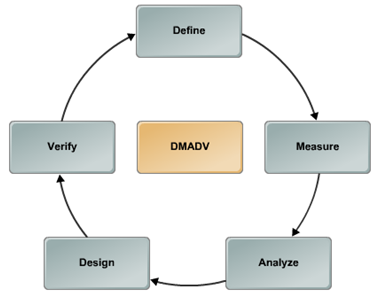Another roadmap of DFSS is DMADV, an acronym for five interconnected phases, namely Define, Measure, Analyze, Design, and Verify. This methodology is used in projects that involve creating a new product or process design.
Define – The project goals are defined so that they are in line with customer requirements and enterprise strategies.
Measure – Characteristics that are critical to quality as well as product and process capabilities are measured.
Analyze – The different process options are analyzed and the best process that is consistent with customer requirements is selected.
Design – The details of the process are designed and optimized to meet the needs of customers followed by the performance of the new design which is tested through pilot runs before implementation.
Verify – In this phase the results are test and implementation of new design is carried out for large scale deployment.
Tags
Organizations strive to eliminate three basic categories of waste in their business processes.
Basic Waste Category are:
- Wasteful activity – Work that adds no value to a product or service. Eliminating such activities from business processes will help organizations cut cost.
- Unevenness – This denotes inconsistencies that exist in a business process. Unevenness and inconsistencies can be avoided by eliminating inventory and supplying items to the production process only when they are needed.
- Overburden – This is caused by an unreasonable or excessive strain on resources. It can be eliminated by simplifying and standardizing processes.
Among these three basic categories of wastes, Lean focuses on eliminating activities that do not add any value. These activities are further classified into seven types of wastes: transport, inventory, motion, waiting, overproduction, over processing, and defects.
Tags
A value-added activity is any activity that increases the worth of a product or service. It directly contributes to meeting customer requirements, and customers are willing to pay for it. Value-added activities also generate a positive ROI for an organization. Without these activities, the process will be affected. A lean team should analyze if activities in a process actually add value to a product or service. They should also determine if activities in a process can be performed in parallel or be merged. This will help organizations deliver outputs more efficiently.
Example: In a manufacturing process, value-added activities can include: receiving a part request, preparing an internal request for a part from production, finding a relevant plant for issuing a request, finding production availability, updating part request information, and the manager processing the part request information and updating the request.

Non-value-added activities are activities that consume resources and time without adding any value to a service or product. Non-value-added activities do not contribute to customer satisfaction and, therefore, customers are not willing to pay for these activities. They are not important to the production and delivery of a product or service, and eliminating them will not affect a process. Because non-value-added activities do not generate any positive ROI but incur only expenditures, organizations should focus on eliminating them.
Example: In the manufacturing process, non-value-added activities can include: sorting and organizing requests, searching for relevant part production locations, checking locations for availability and delivery, generating production requests, and reviewing the status of requests.
Tags
In a Lean manufacturing process, time and resources spent on conveying data and information are regarded as waste. Visual factory tools—such as signs, charts, check sheets, and more— simplify information and reduce resources and time consumed to make it accessible. Clear and concise real-time information and feedback regarding the status of a plant or a process is provided to shop floor employees using visual cues and tools. The visual cues provide unambiguous information needed to perform their jobs at a glance. Simple visual cues—such as color-coded pipes, wires, or flags; painted floor areas; and indicator lights—are simple to use and understand. The type of tool and the location used are determined by identifying the relevance and the information recipient.
Tags
Six Sigma is a customer-focused approach to business process improvement and performance management which encompasses a statistical and method-driven process. In order to effectively deploy the process in your organization, it is necessary to identify the basic elements that drive the Six Sigma methodology. Knowledge of the Six Sigma fundamentals is the first step toward a successful Six Sigma implementation. Before applying any business strategy in an organization, you must identify the goals and benefits of the strategy. You must also recognize the need for such a business strategy in the organization.
Surviving in a business world that is full of competition is crucial to any organization. Six Sigma provides the means to handle declining product prices in the market, which helps any organization compete with the best companies in business. It targets zero defects by setting a common performance goal for the entire organization. Six Sigma helps an organization achieve increased profitability and quality improvement rates, ahead of any of its competitors. Reduced scrap-related costs, rework, improved yield, and increased customer satisfaction are identified in companies striving to achieve Six Sigma.
A Six Sigma initiative differs from other quality improvement methodologies because it ensures that the costs involved in implementation are offset by the gains received from improvements.
The primary goal of Six Sigma is to implement a measurement-based strategy in an organization that concentrates on process improvement and reducing variation. In addition to this, the other important goals of Six Sigma include:
- Reducing the number of defects, leading to the improved quality of a product or service.
- Achieving customer satisfaction by ensuring that customer expectations are met.
- Reducing cycle time, which enables the faster delivery of products.
- And, higher profitability by improving efficiency and effectiveness of the organization.
Tags
In a Continuous improvement journey, improvement projects are nothing but the lifeline. In this series of articles, we covered on the Need for Project Selection and the Criteria for project. Now we’ll answer the big question – Where can I get my projects from? Essentially various sources of the project!
- Customers Interactions: “Customers” are the biggest source for improvement projects. Classically, negative customer sentiments are good places to start. Your customers are unhappy, so it’s time to fix the issue. Mixed or ambiguous sentiments are also relevant places to start.
- Customer Complaints:If your organization has a list of customer complaints, then that is an apt place to commence. Complaints are not only sore for your customers, but for you too. Such complaints may cover a vast product or service attributes such as product or service quality, delivery time, responsiveness, people issues, pricing or areas of monetary impact including warranty claims,process & policy issues.
- Repeat Complaints: You can go one step further and target repeat complaints instead. Repetitive complaints from the same customer with the same tagging indicates high priority area for improvement.
- Enquiries & Requests: Few organizations target the need of customers to call or contact the organization and, reduce them. It might not be a complaint, instead just an enquiry or request. In other words, interactions with the organization that can be avoided. Looking at enquiries and requests serve as a proactive means to identify future problem areas.

- VoC Program output: If your organization conducts structured VoC surveys, then the outputs of such mechanism can be a good source of Continuous Improvement or Lean Six Sigma projects
- Customer Experience (CX) Dipstick: Customer Experience is usually hidden and not so obvious as customer feedback. Structured and unstructured mechanisms can be deployed to understand the customer experience. For example, many organizations now use mystery shopping to unearth issues in customer experience. Observation or Listening posts are also a good way to identify how customer experience can be improved.
- First Time Right (FTR): If you closely have a look at your company’s process, you will find that there are many internal defects (work-in-progress) occurring, such as rework, repairs & in-process rejections. Such defects are silent killers because they drain organization’s efficiency and effectiveness silently. If your organization is measuring FTR, then its improvement can be an ideal project. More evolved organizations use RTY (Rolled Throughput Yield) as a metric which is also a good place to demonstrate Continuous Improvement.
However, most organizations have a simpler measure of success for quality – Defect Rate (% Defective). While there’s nothing wrong with this metric, is a bit holistic and hence factors leading to inefficiencies escape unnoticed with this metric. Nonetheless, it is good starting point for Continuous Improvement projects. - Reliability Data/Warranty data: Field failures are sometimes grave. It can cost you a lot and, the overall cost of ownership for customers might increase esp if the warranty is denied or the product is under breakdown. In broader terms, the principle of warranty is to institute accountability in the event of an untimely failure of an item or the inability of the item to perform its intended function. Experts consider reliability data analysis as a quality measure over time. This reliability analysis is done to analyze whether your product will survive for the time defined by the company in the normal conditions. Improving the reliability of a product can work both ways – organizations can lower its operational cost and provide longer warranty and customers would experience break down less often.
- Process Performance Data: If your organization has a well-defined and structured reporting mechanism for process performance metrics, such as a dashboard or scorecard, then it would be a very good source to identify opportunities for continuous improvement projects. As leadership teams are consumers of such reports, such opportunities can easily gain sponsorship as well.
- Competitive Benchmarking: Benchmarking is a continuous process of comparing your firm’s or company’s practice to those of the competitors or say most successful competitors. In certain cases, you might not be doing well. For example, having control over the delivery time to the customers. Then this can be taken as a project for improvement in our company. So, to generalize, competitive benchmarking results can also be a good source for Continuous Improvement projects.
- Business Plans/Strategies: Gap between strategic plan and reality can be the cause of concern for leadership. Sometimes such problems may be because of supporting processes. They can hinder new business plans or strategies. Such process improvement opportunities are also a good source for projects, provided they are scoped well with well-defined objectives & goals.
- Employee Feedback: While customers don’t see your process but only experience its outcomes, employees have an end to end visibility. They experience problems as customers and can associate inward aspects of such poor experience. Many organizations, pilot their products with employees, because employees are pseudo customers. If you can establish a structured process through which employees are encouraged to share their experience and enable them to take up such opportunities as Continuous Improvement or Lean Six Sigma projects, there’s nothing like it.
All the above can serve as a good source for Continuous Improvement or Lean Six Sigma projects.
Tags
All processes need a control or management mechanism to ensure that they meet or exceed customer expectations consistently. Process parameters that go out of control need to be restored back to their normal values. How fast this has to be done depends on the type of process. For a surgeon, he needs to restore parameters back to normal within seconds. Engineers working in processing plants like paint shops need to react within minutes. However, for some processes, a couple of hours or a couple of days would be good enough.
A process control or management plan, usually prepared in the control phase of a Six Sigma project, provides insights on a reaction or response plan.
A reaction plan or response plan specifies a course of action that is needed to be taken when process control parameters go out of control. And, it includes both immediate and long-term actions to restore a process performance to its desired level.
There are 5 different types of reaction plans that can be considered while creating a process control plan:
- A plan to continue the process with close monitoring: – A process needs to be closely observed to see where it is going wrong, what is causing the parameters to go out of control, and how often is it occurring; for example: the source of the noise level of a generator or machine. Therefore, at this point, continue to run the process but closely monitor it as well. It is indeed, a very low impact reaction plan, but this is good enough for many processes.
- Enforce a manual override: – If a system is running automatically, stop and run it manually in order to exert a little more caution. This not only helps observe which part of the process is failing, it also helps to get a better handling of the process.
- Follow special instructions: – The next thing to do, when out of control parameters have been identified, is to follow instructions that are kept in place; for example: in case of a fire, check the instructions to find the exits, etc. Therefore if instructions are followed, then it will help bring the process back on track.

- Stop and escalate: – If a process goes wrong, and none of the above actions work, only then we should stop a process and escalate it to the experts or concerned department.
- Stop, correct, and resume: – This action can be observed if a process goes wrong and none of the above actions work, and if there is an expert among us who can fix the issue. Then, we can stop the process, correct the process and continue the process; while observing if the process has been restored to its desired level of performance. This reaction plan will have a quick and immediate impact. For some critical processes, this reaction plan is very apt.
The concept of a reaction plan or response plan is not only applicable in control phase, but also for standalone situations. Be sure to follow the 5 steps or types of procedures that need to be observed in the event of a process going out of control.






